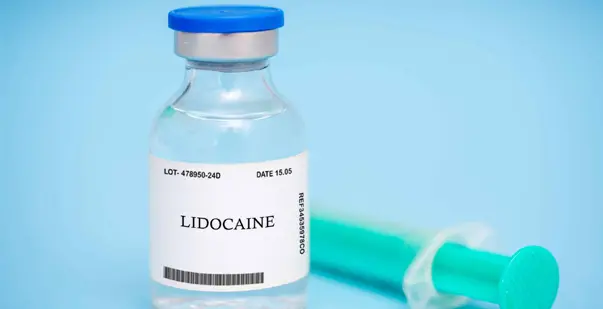Table of content (s)
- What is the recommended first lidocaine dose in cardiac arrest?
- Understanding lidocaine dosing for ventricular arrhythmias vs. other arrhythmias.
- What is the correct timing for the second lidocaine dose in cardiac arrest?
- Lidocaine vs. amiodarone in ACLS.
- What are the side effects of Lidocaine?
- Key considerations for optimal lidocaine dosing.
In advanced cardiovascular life support (ACLS), lidocaine is a primary antiarrhythmic for treating ventricular fibrillation and ventricular tachycardia. Researchers are studying the benefits of using lidocaine in cases of cardiac emergencies. Thus, it is important to get the lidocaine dose right.
You must start with 1-2 mg/kg and then give a continuous infusion. This must be continued until arrhythmia is resolved or alternative treatments are initiated.
Lidocaine is also used to manage pain after surgery with the same dosing method. Knowing how lidocaine works in the body is important for its safe and effective use in ACLS and pain control after surgery. So, let us explore the key considerations and recommended dosage of lidocaine in a cardiac arrest.
Master ACLS Now
Get ACLS certified with confidence
What is the recommended first lidocaine dose in cardiac arrest?
Let us take a look at the correct dosages of lidocaine:
- The recommended first dose of lidocaine in cardiac arrest is 1.0 to 1.5 milligrams per kilogram of body weight.
- This initial dose is used for treating ventricular arrhythmias like ventricular fibrillation, which can lead to cardiac arrest.
- In some cases, a second dose of 0.5 to 0.75 milligrams per kilogram is given if recommended.
Read More: ACLS Certification New York
Understanding lidocaine dosing for ventricular arrhythmias vs. other arrhythmias.
Lidocaine, a local antiarrhythmic agent, is used to manage various cardiac arrhythmias. Its dosing depends on whether it is used for ventricular arrhythmias or other types of arrhythmias.
| Indication | Loading Dose | Maintenance Dose | Notes |
| Ventricular Arrhythmias | 1-1.5 mg/kg IV bolus | 1-4 mg/min IV infusion | Additional boluses of 0.5-0.75 mg/kg can be given every 5-10 minutes up to a total of 3 mg/kg.
|
| Other Arrhythmias | Generally not recommended or used | Not applicable | Lidocaine is not used for atrial arrhythmias due to the limited efficacy and alternatives available. |
Lidocaine is effective and primarily used for ventricular arrhythmias due to its ability to stabilize the cardiac membrane. For other arrhythmias, alternative medications are preferred.
Read more: In Depth: Narrow Complex Tachycardia
What is the correct timing for the second lidocaine dose in cardiac arrest?
The correct timing for the second lidocaine dose in cardiac arrest is 3-5 minutes after the first dose. Studies suggest that a 2 mg/kg IV dose is ideal during cardiac arrest, and provides optimal lidocaine levels in the heart and brain. This timing ensures effective lidocaine levels for better outcomes.
Lidocaine vs. amiodarone in ACLS.
Lidocaine and amiodarone are both used in ACLS protocols to manage ventricular arrhythmias, including ventricular fibrillation (VF) and pulseless ventricular tachycardia (VT). Each drug has distinct properties, indications, and considerations. Let us take a look:
| Aspect | Lidocaine | Amiodarone |
| Mechanism of Action | Sodium channel blocker | Potassium channel blocker, with sodium, calcium, and beta-blocker effects |
| Indications | VF, pulseless VT, and stable VT | VF, pulseless VT, and stable VT |
| Initial Dosing in ACLS | 1-1.5 mg/kg IV bolus | 300 mg IV bolus |
| Repeat Dosing | 0.5-0.75 mg/kg every 5-10 minutes, up to 3 mg/kg total | 150 mg IV bolus if initial dose ineffective |
| Maintenance Infusion | 1-4 mg/min IV | 1 mg/min for 6 hours, then 0.5 mg/min for 18 hours |
| Side Effects | CNS toxicity, hypotension, bradycardia | Hypotension, bradycardia, QT prolongation, pulmonary toxicity |
| Onset of Action | Rapid (1-2 minutes) | Rapid (within minutes) |
| Duration of Action | Short (10-20 minutes) | Long (hours to days) |
| Half-Life | 1.5-2 hours | 58 days |
| Preferred Use | Alternative if amiodarone is unavailable or contraindicated | First-line treatment in refractory VF/pulseless VT after defibrillation |
Master ACLS Now
Get ACLS certified with confidence
What are the side effects of Lidocaine?
Lidocaine administration has a few side effects. Some of these include:
- Neuropsychiatric symptoms (1.8-100% incidence).
- Skin reactions like blanching, erythema, and urticaria.
- Disorientation and psychiatric disturbances.
- Life-threatening effects like seizures, confusion, and breathing problems.
- Allergic reactions, including hives, swelling, and difficulty breathing
- Transient radicular irritation syndrome with spinal anesthesia.
- Rare true hypersensitivity allergy reaction.
Key considerations for optimal lidocaine dosing.
When using lidocaine for arrhythmias, several important factors must be taken into account to ensure safety. These include:
-
Patient Weight
Dose lidocaine based on the patient’s weight, typically 1-1.5 mg/kg for an initial bolus.
-
Timing of Doses
Administer the second dose 3-5 minutes after the initial dose to maintain therapeutic levels. This timing helps sustain effective concentrations in the bloodstream.
-
Total Dose Limit
Do not exceed a total dose of 3 mg/kg to prevent toxicity. Monitoring the cumulative dose is essential for patient safety.
-
Monitoring for Side Effects
Watch for CNS toxicity signs, such as drowsiness, confusion, and seizures, as well as cardiovascular effects like hypotension and bradycardia.
-
Renal and Hepatic Function
Adjust the dose for patients with renal or hepatic impairment. Both conditions can affect lidocaine metabolism and excretion.
-
Continuous Infusion Rate
Set the maintenance infusion rate between 1-4 mg/min based on clinical response and side effect profile. This helps maintain therapeutic levels without causing toxicity.
Read more: Acute Inferior STEMI with Right Ventricular Infarction and Cardiac Arrest
Conclusion
Properly administering ACLS lidocaine is vital for treating cardiac emergencies like ventricular arrhythmias. It is important to know when and how to use lidocaine versus amiodarone. It helps ensure effective treatment choices. Following recommended dosing and monitoring guidelines is the key to improving patient outcomes during critical situations.







